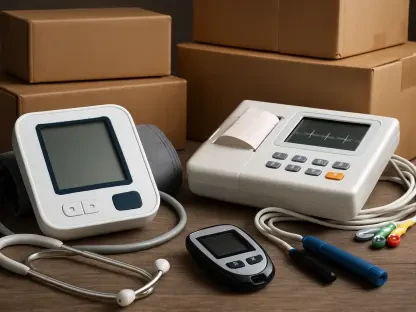The rapid advancement of wearable technology has significantly impacted various sectors, including workplace health and safety. These devices, capable of generating vast amounts of personal and environmental data, offer promising solutions for monitoring worker safety and detecting environmental hazards. However, integrating wearables into the workplace comes with challenges, particularly concerning data privacy, reliability, and practical application in diverse work environments.
The Growing Market for Wearable Tech
Expanding Applications
The global market for wearable technology is projected to reach $265.4 billion by 2026. This growth includes consumer electronics, healthcare devices, enterprise solutions, and industrial technologies. Wearables are becoming increasingly prominent in health and safety programs, providing real-time monitoring of worker movements, vitals, and environmental conditions.
Wearable technology’s applications are expanding rapidly beyond traditional uses, with workplace safety emerging as a key area where these devices show significant promise. Real-time monitoring capabilities are especially useful in industries fraught with hazards, such as construction, manufacturing, and mining. Devices like smart helmets, equipped with environmental sensors, and smart vests, monitoring vital signs, are becoming indispensable in offering a comprehensive overview of workers’ conditions and immediate environment. The technology is evolving to include capabilities like detecting heat stress signs and providing predictive analytics such as fatigue forecasts tailored to shift patterns, which help prevent overexertion and related accidents.
Wearable devices are designed to preemptively identify risks before they escalate into serious injuries. Smart bands, watches, and glasses can monitor physiological data and environmental factors, and alert workers and supervisors to potential health issues. For instance, fluctuations in heart rate or body temperature detected by these devices can indicate the onset of heatstroke. This proactive monitoring not only improves individual safety but also enables a macro-level analysis of workplace conditions, empowering employers to make informed decisions about workloads, shifts, and operational environments. As wearable tech continues to advance, its role in enhancing workplace safety is expected to grow correspondingly.
Enhancing Workplace Safety
Wearable devices aim to prevent occupational injuries, detect health issues like heat stress, and provide predictive analytics such as fatigue forecasts tailored to workers’ shifts. These capabilities highlight the potential of wearables to enhance workplace safety and improve overall worker well-being.
The ability of wearable technology to significantly enhance workplace safety cannot be overstated, as it offers tools and insights previously unavailable or impractical. Devices like smart helmets and vests come equipped with sensors that can monitor ambient temperatures, air quality, and potentially harmful gases, alerting workers and supervisors to hazardous conditions. Moreover, wearable tech’s built-in GPS allows for accurate tracking of workers’ locations, which is invaluable in large or complex sites. This real-time location data can be crucial in emergencies, ensuring rapid response and assistance.
Predictive analytics are another groundbreaking feature of wearable technology, offering employers the ability to anticipate and mitigate risks proactively. Fatigue monitoring systems, for instance, can analyze sleep patterns and on-the-job activity to predict when a worker might be at risk of fatigue-related accidents. These systems can then suggest breaks or shift adjustments to ensure workers are operating at peak performance, thereby reducing the likelihood of errors or accidents. By providing a detailed understanding of both individual and collective health and safety metrics, wearables facilitate a culture of proactive, rather than reactive, safety management.
Worker Acceptance and Utility
Growing Willingness to Adopt
There is a notable increase in workers’ willingness to use wearable technology professionally. A significant study indicates that 59% of individuals with previous personal experience using wearables are open to using them in their workplace. This trend is promising for employers looking to integrate wearable tech into their health and safety programs.
The growing willingness of workers to adopt wearable technology in the workplace marks a crucial shift toward modernizing health and safety measures. This acceptance is rooted in the familiarity many employees have with wearable devices through personal use, such as fitness trackers and smartwatches. This pre-existing comfort significantly reduces the learning curve and enhances the adoption rate in professional settings. Workers are recognizing that wearable technology is not just a gimmick but a valuable tool that can enhance their safety and overall well-being on the job.
The practicality of these devices in addressing specific workplace hazards plays a significant role in their acceptance. For example, wearables that monitor exposure to harmful chemicals or excessive noise levels provide real-time data that can be used to make immediate adjustments in work practices or protective equipment. This kind of direct, tangible benefit is readily appreciated by workers who are on the frontline and directly impacted by workplace safety protocols. Furthermore, the data collected by wearables can also be used to ensure compliance with occupational health and safety regulations, providing an additional layer of protection and reassurance for both employees and employers.
Practical Benefits
Employees have shown readiness to utilize wearable tech for safety enhancements and hazard identification. This acceptance reflects the practical benefits that wearable devices can offer, making them a valuable tool for improving workplace safety.
The practical benefits of wearable technology in the workplace are being increasingly recognized by employees, whose firsthand experiences often highlight the tangible advantages these devices offer. Enhanced safety is one of the most immediate and impactful benefits, with wearables providing real-time data on various health and environmental parameters. This data can be used to quickly identify potential hazards, such as exposure to extreme temperatures or harmful chemicals, and take immediate corrective actions. Workers equipped with these devices are better informed and more capable of responding to unsafe conditions, thereby reducing the risk of accidents and injuries.
Moreover, wearable technology’s capability to provide continuous health monitoring helps in early detection of health issues, allowing for timely medical intervention. For instance, smart watches can track vital signs like heart rate and blood pressure, alerting workers to any abnormalities that might indicate the onset of a health problem. This real-time health monitoring is particularly beneficial for those working in physically demanding or high-stress environments, where quick identification of health concerns can be lifesaving. By offering these practical advantages, wearable technology fosters a safer, more responsive work environment, contributing to overall worker well-being and productivity.
Wearable Tech as a Risk Management Tool
Integrating into Broader Strategies
Experts caution that wearable technology should be viewed as part of broader risk management strategies rather than a standalone solution. While wearables can provide valuable data and insights, they must be integrated into existing safety protocols and measures to be truly effective.
However, the true potential of wearable technology in enhancing workplace safety lies in its integration into broader risk management frameworks. Experts suggest that these devices should not be seen as standalone solutions but as complementary tools that enhance existing safety protocols. This approach ensures a holistic view of workplace safety, where data from wearables are used alongside other risk management strategies to provide a comprehensive safety net. For example, wearable data can be combined with traditional risk assessments and safety audits to identify patterns and trends that might go unnoticed otherwise.
Furthermore, the integration of wearable technology into safety training programs can improve their effectiveness. Workers can receive personalized feedback based on their wearable data, helping them understand how their actions impact their safety and how they can mitigate risks. This data-driven approach fosters a more informed and engaged workforce, which is crucial for maintaining a safe working environment. By embedding wearables within the broader risk management strategy, employers can leverage the best of both worlds – advanced technology and traditional safety measures – to create a more robust, comprehensive safety culture.
Reliability and Practical Challenges
Validating the reliability and accuracy of wearable devices is crucial before implementation. Many devices designed for athletes and the general public may not withstand the rigors of typical work environments, leading to issues such as reduced comfort and poor worker compliance. Thorough vetting and trials are essential to ensure suitability and effectiveness.
One of the significant challenges in implementing wearable technology in the workplace is ensuring the reliability and accuracy of these devices under varying and often harsh conditions. Many wearables on the market today were initially designed for consumer use, primarily for fitness tracking or personal health monitoring. These devices may not always be durable or reliable enough for industrial settings, where they must withstand extreme temperatures, moisture, dust, and physical impacts. Therefore, it is imperative to subject these devices to rigorous testing and validation processes to ascertain their suitability for specific work environments.
Moreover, comfort and user compliance are also critical factors that need to be addressed for the successful implementation of wearable technology. If the devices are cumbersome, uncomfortable, or interfere with the workers’ tasks, there is a high likelihood of non-compliance, rendering the technology ineffective. Employers need to involve workers in the evaluation process to gain feedback on the practicality and comfort of the wearables. This participatory approach ensures that the chosen technology not only meets safety needs but is also user-friendly and accepted by the workforce. Ensuring the reliability and practicality of wearable devices through thorough vetting and trials is crucial for their successful integration into workplace safety programs.
Balancing Safety and Privacy
Legal Considerations
Balancing employee health and privacy is a significant concern with wearable technology. Employers must avoid overreach in data collection and consult legal experts to develop robust privacy protection policies. Collecting only relevant data, limiting access, and ensuring timely data destruction are critical measures to mitigate legal risks and uphold employee trust.
The implementation of wearable technology in the workplace raises significant legal considerations, particularly concerning data privacy. While the primary goal of these devices is to enhance worker safety, the collection and utilization of personal data can lead to potential privacy invasions if not managed correctly. Employers must ensure that they are only collecting data directly relevant to workplace safety and not overstepping into areas that could be deemed intrusive. This requires a clear delineation of data boundaries and meticulous attention to privacy laws and regulations.
Employers are advised to consult with legal experts to develop robust privacy protection policies. These policies should outline what data will be collected, how it will be used, who will have access to it, and for how long it will be retained. Transparent communication with employees regarding these policies is crucial to build trust and ensure compliance. In addition, implementing measures such as data anonymization, encryption, and regular audits can further protect employee privacy. By balancing the need for safety with the right to privacy, employers can mitigate legal risks and create a more positive and trustful workplace environment.
Implementing Wearable Technology Programs
Successfully integrating wearable tech into workplace safety programs involves securing worker buy-in. Clear, well-communicated policies and procedures, along with initial trials, can demonstrate the practical benefits of these devices and address potential concerns, paving the way for broader acceptance and compliance.
Securing worker buy-in is fundamental to the successful implementation of wearable technology in workplace safety programs. This process begins with clear and transparent communication about the purpose, benefits, and data policies associated with the use of wearables. Employees need to understand how these devices will enhance their safety and well-being, as well as what data will be collected and how it will be used. Transparency fosters trust and helps alleviate concerns about privacy and data misuse.
Initial trials with small groups or at management levels can serve as a proof of concept, demonstrating the practical benefits of wearable technology in real-world scenarios. These pilots can provide valuable insights into user experience, device reliability, and potential areas for improvement. Feedback from these trials should be actively sought and incorporated into the wider rollout plan. Additionally, providing training sessions to educate workers on how to use the devices and interpret their data can further enhance acceptance and compliance. By taking a thoughtful, phased approach, employers can effectively integrate wearable technology into their safety programs, ensuring a smooth transition and broad buy-in.
Enhancing Safety Culture
Empowering Workers
Wearable technology can bolster safety culture within organizations. These devices empower workers by providing concrete data to back up their claims regarding unsafe conditions. This empowerment promotes a proactive safety culture, reducing the likelihood of accidents and fostering a more diligent approach to occupational health.
Wearable technology has the potential to significantly enhance the safety culture within organizations by empowering workers with real-time data and insights. These devices provide workers with concrete information about their health and safety conditions, enabling them to make informed decisions and take proactive measures. For instance, if a wearable device alerts a worker to high levels of a harmful substance in the air, the worker can immediately take steps to mitigate exposure, such as donning additional protective gear or evacuating the area. This immediate access to data not only enhances individual safety but also fosters a culture of vigilance and responsiveness.
Moreover, wearable technology enables workers to substantiate their concerns about unsafe conditions with empirical data, thereby strengthening their position when reporting hazards. This data-driven approach encourages a more open and constructive dialogue between employees and management regarding safety issues. It also reinforces the importance of adhering to safety protocols and guidelines, as workers can see firsthand the impact of their actions on their health and safety. By empowering workers with technology, employers can promote a more engaged and proactive approach to occupational health, ultimately reducing the likelihood of accidents and enhancing overall safety culture.
Promoting Proactive Safety Measures
The rapid growth of wearable technology has greatly affected various sectors, especially workplace health and safety. These devices can produce massive amounts of personal and environmental data, providing innovative solutions for monitoring employee safety and identifying environmental risks. By tracking workers’ vital signs and surroundings in real-time, wearables can promptly alert management to potential hazards, thus enhancing preventive measures and emergency responses. Despite these benefits, incorporating wearables into the work environment is not without hurdles. Central challenges include ensuring data privacy, maintaining device reliability, and effectively applying these technologies in diverse work settings. Protecting personal data from breaches and ensuring accurate, uninterrupted data flow are critical. Moreover, adapting wearables to various industries—ranging from construction to office settings—requires tailored strategies to address specific needs and conditions. Hence, while wearable technology holds promise for advancing workplace safety, addressing these challenges is essential for its effective deployment.









